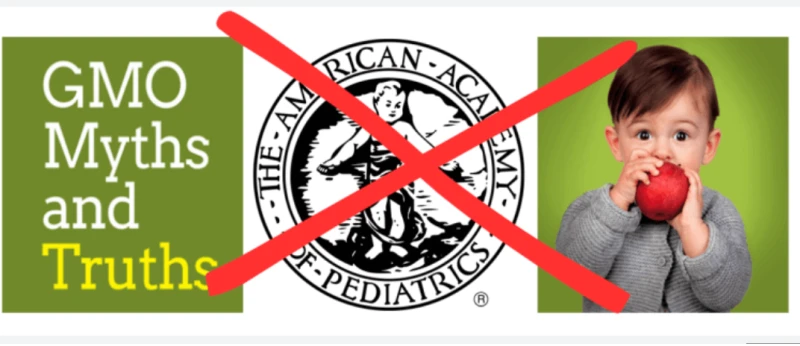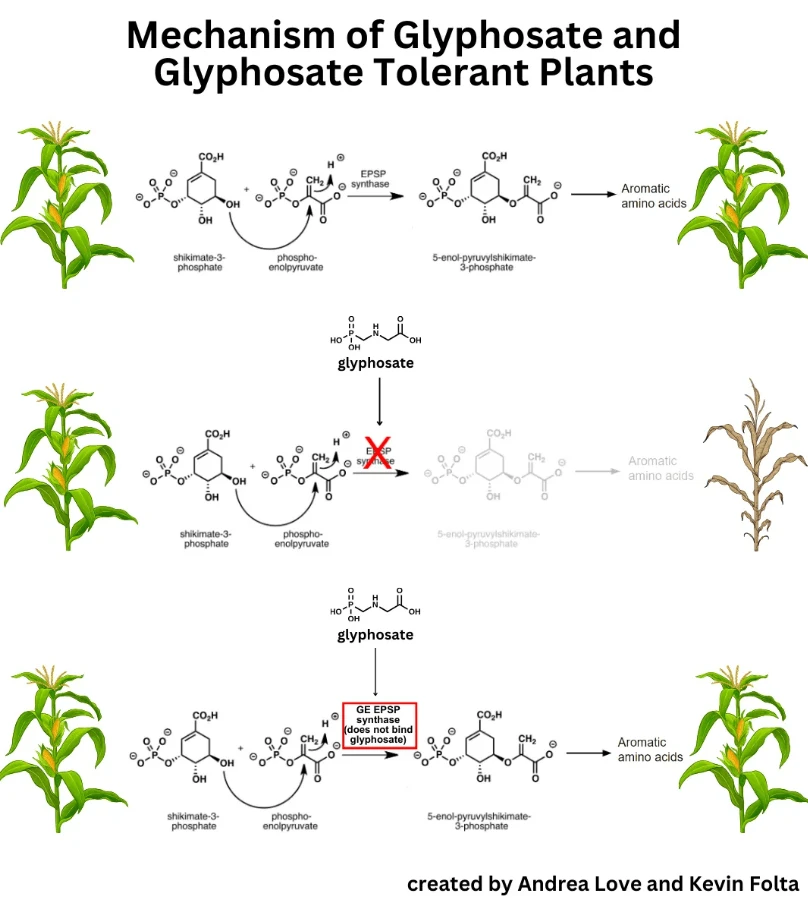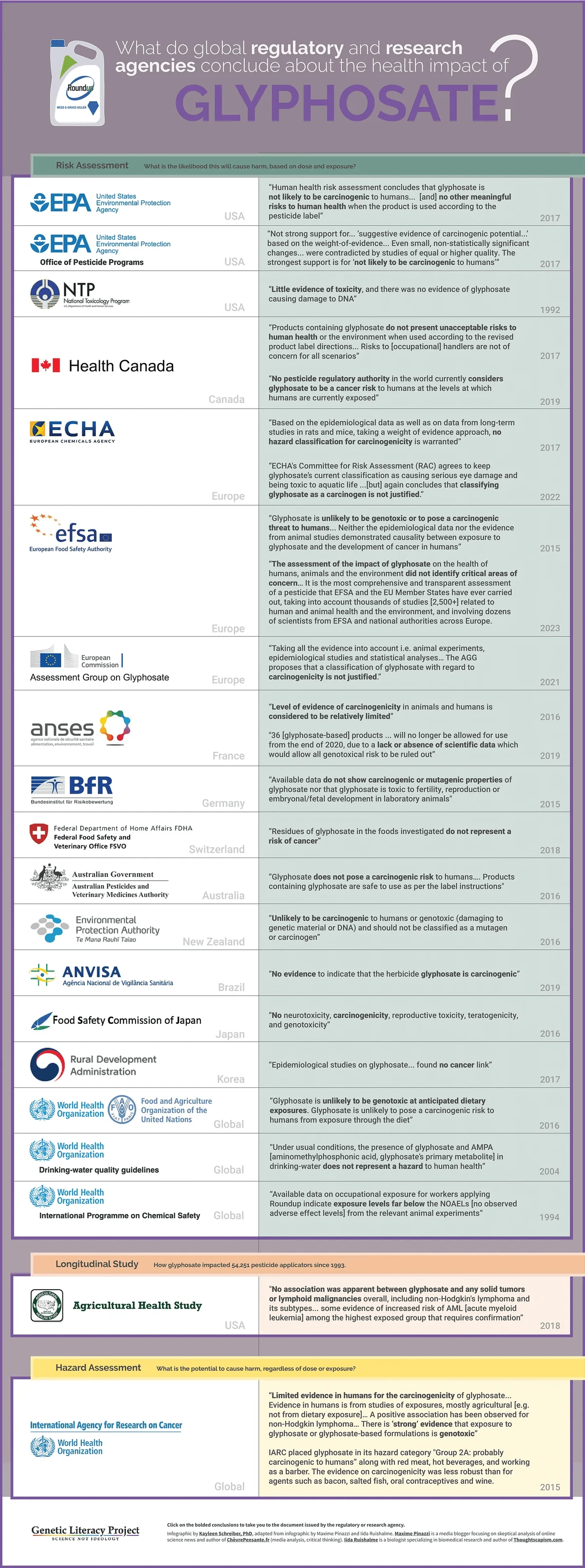Viewpoint: Aftershocks from American Academy of Pediatrics attack on glyphosate—‘Misinformation about the genetic engineering of crops hinders the development of sustainable agriculture
Viewpoint: Aftershocks from American Academy of Pediatrics attack on glyphosate—‘Misinformation about the genetic engineering of crops hinders the development of sustainable agriculture technologies’


But it’s time we discuss the data on glyphosate.
Oh, and before we head off: I don’t work in agriculture at all. I am just a biomedical scientist who sees the harms of misinformation being a global public health threat. So why do I care about glyphosate and GMO (genetically modified organism) crops so much?
Because misinformation about glyphosate and the genetic engineering of crops directly hinders the development and adoption of sustainable agriculture technologies.
The climate crisis is accelerating. This has direct impacts on the stability and ability to grow crops in regions where they previously were able to. Droughts, floods, erosion, increasing temperatures. Plants that are needed to feed the planet don’t naturally adapt that quickly. So humans have to help them along if we are to continue to provide food to the billions around the world.
That means we need to adapt our agricultural methods. Genetic tools could facilitate this
For example, Argentina is one of the top producers of wheat in the world. But climate change has made production of wheat incredibly unstable, with prolonged periods of drought, excessive heat, and more impacting the growing season. To address this, an Argentinian-based biotech developed a genetically engineered (GE) wheat containing a gene from sunflowers that can increase resilience in drought. This wheat, HB4, completed a decade-long field trial and was recently approved to be grown there and in Brazil. The US regulatory agencies reviewed all of the data in 2022 and concluded there are no safety concerns about this wheat, but it is not currently approved to be grown here. Australia, Colombia, Indonesia, New Zealand, and Nigeria have all approved the import of processed wheat or finished products as well.
Note: there is NO commercial GE wheat grown anywhere else besides Argentina and Brazil, just so you know.
However, anti-biotech activist organizations propagate unfounded fears about GMO technologies and chemophobia about pesticides like glyphosate used on GE crops, while failing to acknowledge that many GE crops are created to REDUCE the number of pesticides that need to be applied exogenously. And remember: organic farming, and even non-GMO conventional farming, use pesticides.
As such, this messaging ends up in the ears of legislators and policymakers and has directly hampered the adoption and integration of genetic technologies as sustainable tools to improve the stability and yield of our food production.
GMO crops are created to serve a specific purpose: to add an advantageous trait
Just like with genetic technologies used to treat human diseases, genetic technologies for plants are used to impart some sort of benefit. Unfortunately, with anti-biotech messaging, this logic is lost. Commonly repeated refrains harp on false claims related to “farmers being able to douse things with pesticides,” when the opposite reality is actually the case.
Also: farmers are trying to produce food while not breaking the bank. Any pesticides that need to be used to control pests and ensure you can actually harvest food are going to be used at the lowest possible level to accomplish that. Because all of these inputs cost money, whether you’re talking conventional or organic pesticides. The more you need to use, the more money they’re spending. This is a basic business strategy.
I digress. As a result of this concerted anti-biotech effort, we only have 13 foods that have GE options in the US – one of which is not a crop:
Alfalfa, ArcticTM apples, canola, corn, cotton, BARI Bt Begun eggplant, papaya, pink pineapple, potato, AquAdvantage® salmon, soybean, squash, sugarbeet, and Bt sugarcane. Even among these, they have different genetic traits. For example, papaya is engineered to resist the papaya ringspot virus, which all but wiped out papaya in Hawaii several decades ago. Without GMO papaya, farmers (and consumers) wouldn’t have papaya here.
Glyphosate is a specific herbicide that is used on glyphosate-tolerant GE crops
So, of these, herbicide-tolerant crops exist for corn, cotton, soybeans, alfalfa, canola, and sugar beets. These crops are genetically altered to withstand herbicides that are considered broad spectrum: meaning, if applied to control weeds that are parasitizing crop fields and taking nutrients needed to grow foods, it would kill the crops as well. Previously, controlling weeds would require multiple different chemicals, manual labor, and soil tilling. These things have obvious cost, ecological impact, and safety concerns.
Enter: genetic tools that can improve farming
Herbicide-tolerant (HT) crops mean that farmers can use a broad-spectrum herbicide but it won’t target the crop, only the weeds. It also means farmers can reduce tilling of soil, which minimizes nutrient leaching, erosion, and other ecologically damaging processes. This all sounds beneficial, right? Absolutely. That’s why the resistance to these things is so baffling, but it is a result of a concerted disinformation campaign over decades.
The first herbicide-tolerant crop approved was soybean in 1996 in the US: nearly 30 years ago. Now, the majority of herbicide-tolerant crops grown are corn, cotton, and soybeans.
22 years before the GE soybean was approved, the herbicide in question, glyphosate, came to market. Glyphosate [N-(phosphonomethyl) glycine] is a non-selective herbicide, which means it targets and can kill plant species indiscriminately. It was first on the market at RoundUp in 1974, but today, there are over 750 different pesticides that contain glyphosate (also why the “RoundUp is toxic” claims are somewhat ironic).
Glyphosate inhibits an enzyme specific to plants
Aside from the decades of data that demonstrate glyphosate does not pose a risk to humans, other mammals, insects, etc., let’s talk about the chemical mechanism.
Glyphosate kills plants by interfering with 5-enolpyruvylshikimate-3-phosphate synthase (EPSPS), an enzyme essential for the production of key amino acids. If plants can’t synthesize those amino acids, the plant can’t make proteins (many of those are structural), and the plant wilts and dies. All plants have this biochemical pathway, which is why glyphosate is a broad spectrum herbicide.
Humans do NOT have this pathway or this enzyme, nor do other animals, which is why glyphosate has no direct pharmacological impact on people.

300 expert institutions, dozens of international regulatory bodies, and over 5,500 studies demonstrate GMO crops and glyphosate are safe
Glyphosate has no mechanism of action on people. That’s why dozens of international regulatory bodies have therefore recognized glyphosate as a low-toxicity chemical with infinitesimal risk at levels encountered.
For over three decades, GMO foods have been part of the global food supply. Extensive evidence from the United States, Canada, Argentina, Brazil, and many other countries suggests no health risks associated with these foods. Despite the consumption of hundreds of trillions of GMO meals, there has not been a single documented case of illness, either short or long-term, linked to GMO foods. There is no evidence suggesting a link to genetic mutations, cancers, organ damage, or fertility problems from GMO consumption. This is supported by nearly 300 expert institutions and over 5,500 studies, indicating robust scientific consensus.
There is no data to suggest glyphosate is linked to cancers of any time in humans
Usually, people who claim glyphosate causes cancer are citing the International Agency for Research on Cancer (IARC) monograph that classified glyphosate as “probably carcinogenic,” which yes, could sound scary. But, if you recall from my piece on IARC methodology, the IARC uses a hazard-based approach. This means they do not consider actual exposures or likelihood.
Over the years, IARC has evaluated more than 115 agents, finding all but one can “cause cancer”. IARC does not conduct original research; it only reviews existing data. On top of that, IARC even conceded in their summary that there was NO human evidence to suggest this classification.
This category, 2B, is the same as eating red meat, drinking hot coffee, frying foods, going to a barber or hairdresser, and working the night shift.
It gets worse.
IARC members ignored robust data that demonstrated glyphosate was not linked to cancer
In 2017, Reuters reported that one of the members of the IARC committee tasked with evaluating glyphosate in 2015 did not disclose the largest study on pesticide applicators that demonstrated no link between glyphosate exposure as a farm worker and cancer.
Here, the final published study in question: a long-term longitudinal study of over 54,000 pesticide applicators which found no association between glyphosate and any solid or hematologic cancers (lymphomas).
Reuters found draft documents and compared them to the final published monograph and found that at the 11th hour, ten TEN significant changes were made that changed the narrative, as the panel was on the verge of concluding that glyphosate poses to cancer risks.. In each of those changes, data that demonstrated glyphosate was not associated with cancer were removed and replaced with weaker data that suggested a link.
Why did IARC omit this, the most robust epidemiological study, and instead use weak mouse and Petri dish studies to instill fear among the public? Potential conflicts of interest?
The reality: there is no risk of cancer associated with glyphosate for pesticide applicators or for people who might be consuming trace residues in finished foods
Even with the IARC’s bizarre and unsupported classification of glyphosate, they found “limited evidence” of carcinogenicity in agricultural workers exposed to glyphosate. In science language, that means there isn’t causal evidence.
On top of that, there is no risk from the micro-traces that might be found in foods. We are talking parts per million, parts per billion, parts per trillion. Remember: detection does not equal relevance, especially when using sensitive analytical chemistry tools.
Even IARC conceded that there is no known link between trace dietary glyphosate exposure and cancer.
On the flip side, twenty-three independent regulatory reviews that use risk assessment, meaning they actually assess the real-world likelihood of a chemical causing cancer, have found that there is no relationship between glyphosate and cancer (summarized in the GLP graphic below).

Why does this myth persist, even after over 30 years of data demonstrating glyphosate is not linked to cancers at all?
Clickbait headlines, frivolous lawsuits, and anti-science activist organizations.
I can’t tell you how many times I have heard: “Look at the lawsuits: RoundUp causes cancer.” It’s critical to realize that lawsuits and jury trials are not scientific evidence of health effects, merely that a jury was persuaded by a convincing (i.e. emotional) appeal. Anyone can sue anyone for anything, and juries are not inherently scientific experts. This is a red herring that ignores 50 years of scientific evidence. And, for the record, Monsanto (now Bayer) has won and lost lawsuits. Neither of those outcomes is scientific evidence.
Unfortunately, these falsehoods gain new legs when medical organizations like the AAP platform legitimize them. In their new Clinical Report, they do the same thing that the EWG has a history of doing. AAP ignores all of the data from those 20 global regulatory agencies and fixates on the IARC’s hazard assessment, which doesn’t even say the things the authors of the piece in Pediatrics claim!
AAP ignores all the data the actual RISK of glyphosate exposure, which demonstrates that there is no relationship between glyphosate (even for farmers or applicators) and negative health outcomes.
Why does the AAP ignore the evidence and spread false messaging that will undoubtedly lead people to consume fewer fruits and vegetables?
I can’t say for sure, but some ideas relate to obvious conflicts of interest. One of the lead authors of the article, Philip Landrigan, has close ties to the Heartland Health Research Alliance (HHRA), an activist organization that has a long history of anti-GMO and conventional agriculture positions and is majority-funded by large organic agriculture corporations.
AAP is legitimizing unsubstantiated falsehoods that will ultimately harm public health
On top of the fact that there isn’t evidence that glyphosate poses a risk. Moreover, the AAP and other activist organizations insinuate that glyphosate is on fresh produce items that you’re going to buy at the store.
That is false. If you recall, the HT crops include soybeans, corn, and cotton – which are primarily used in animal feeds, non-edible consumer products, and cooking oils. Glyphosate is NOT being used on fresh produce items. Ironically, AAP’s solution is to buy organic produce – which, uses plenty of pesticides and echoes of the elitist and unsubstantiated claims from EWG and other fear-mongering entities.
This type of messaging misleads people, scares them from perfectly safe and nutritious foods, and cements these lies as “facts” when they are nothing more than fabrications. More than that, these types of messages actually will cause people to consume fewer fruits and vegetables, which poses a far greater health impact than unfounded concerns about glyphosate (or other pesticides). This is a perfect illustration of the harms of the risk perception gap.
Dr. Andrea Love has a PhD in Immunology and Microbiology. Andrea is a subject-matter expert in infectious disease immunology, cancer immunology, and autoimmunity and is adept at translating complex scientific data and topics for the public and healthcare providers. Follow Andrea on X @dr_andrealove
A version of this article was originally posted on Dr. Love’s blog Immunologic and is reposted here with permission. Any reposting should credit both the GLP and original article.

 | Videos | More... |

Video: Nuclear energy will destroy us? Global warming is an existential threat? Chemicals are massacring bees? Donate to the Green Industrial Complex!
 | Bees & Pollinators | More... |

GLP podcast: Science journalism is a mess. Here’s how to fix it

Mosquito massacre: Can we safely tackle malaria with a CRISPR gene drive?

Are we facing an ‘Insect Apocalypse’ caused by ‘intensive, industrial’ farming and agricultural chemicals? The media say yes; Science says ‘no’
 | Infographics | More... |

Infographic: Global regulatory and health research agencies on whether glyphosate causes cancer
 | GMO FAQs | More... |

Why is there controversy over GMO foods but not GMO drugs?

How are GMOs labeled around the world?

How does genetic engineering differ from conventional breeding?
 | GLP Profiles | More... |

Alex Jones: Right-wing conspiracy theorist stokes fear of GMOs, pesticides to sell ‘health supplements’




 Viewpoint — Fact checking MAHA mythmakers: How wellness influencers and RFK, Jr. undermine American science and health
Viewpoint — Fact checking MAHA mythmakers: How wellness influencers and RFK, Jr. undermine American science and health Viewpoint: Video — Big Solar is gobbling up productive agricultural land and hurting farmers yet providing little energy or sustainabilty gains
Viewpoint: Video — Big Solar is gobbling up productive agricultural land and hurting farmers yet providing little energy or sustainabilty gains Fighting deforestation with CO2: Biotechnology breakthrough creates sustainable palm oil alternative for cosmetics
Fighting deforestation with CO2: Biotechnology breakthrough creates sustainable palm oil alternative for cosmetics Trust issues: What happens when therapists use ChatGPT?
Trust issues: What happens when therapists use ChatGPT? 30-year-old tomato line shows genetic resistance to devastating virus
30-year-old tomato line shows genetic resistance to devastating virus California, Washington, Oregon forge immunization alliance to safeguard vaccine access against federal undermining
California, Washington, Oregon forge immunization alliance to safeguard vaccine access against federal undermining The free-range chicken dilemma: Better for birds, but with substantial costs
The free-range chicken dilemma: Better for birds, but with substantial costs ‘You have to treat the brain first’: Rethinking chronic pain with Sanjay Gupta
‘You have to treat the brain first’: Rethinking chronic pain with Sanjay Gupta
